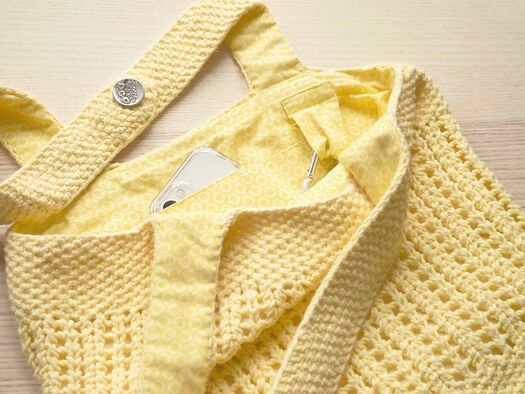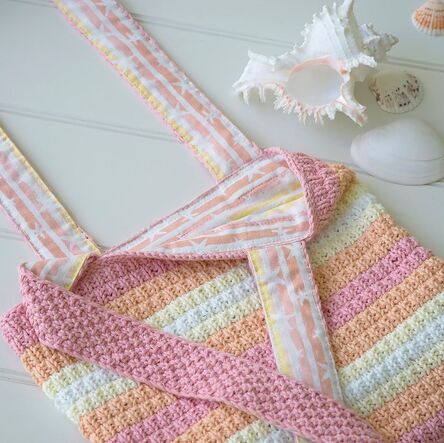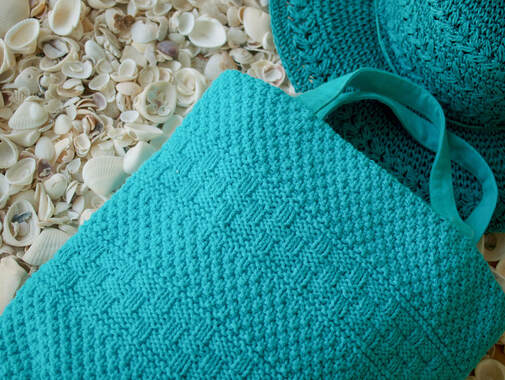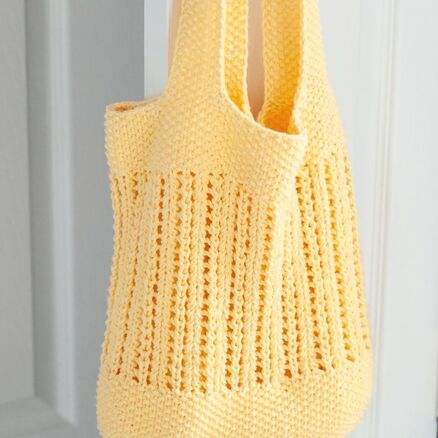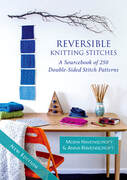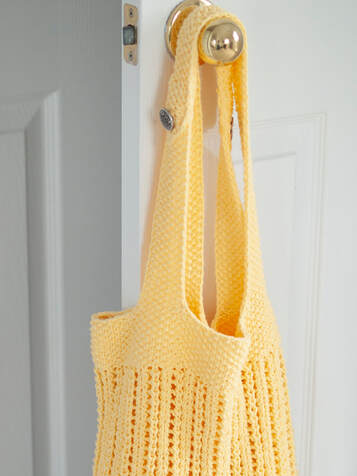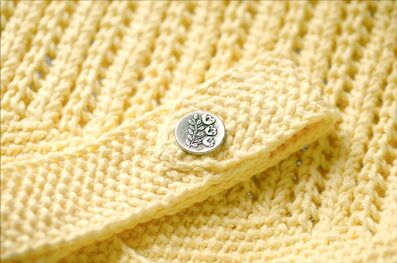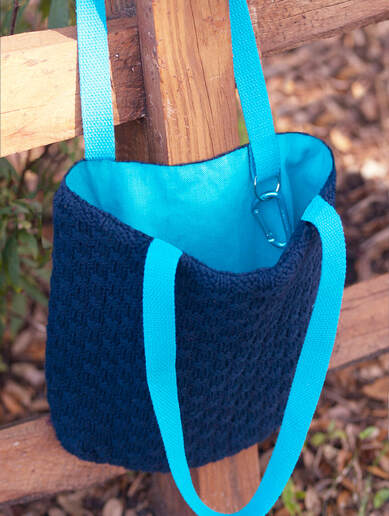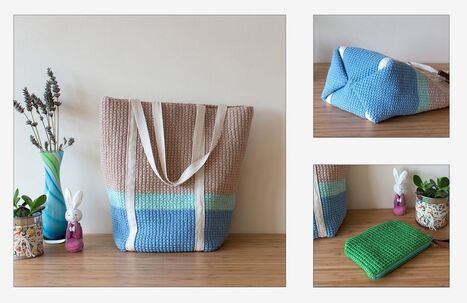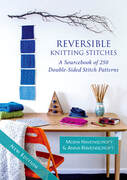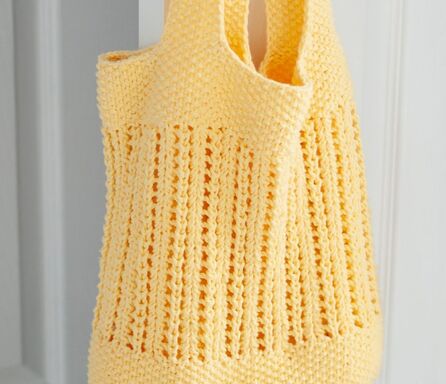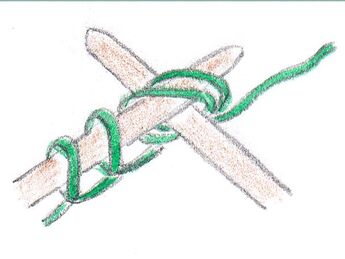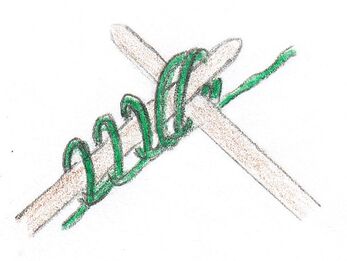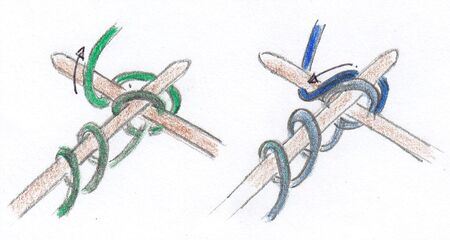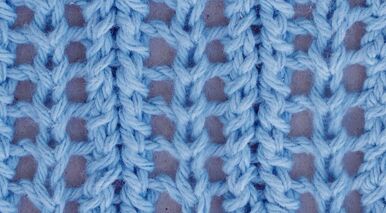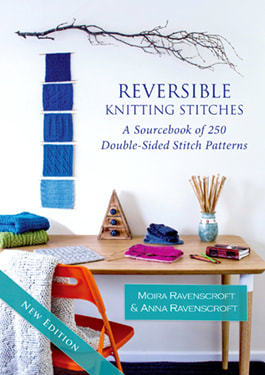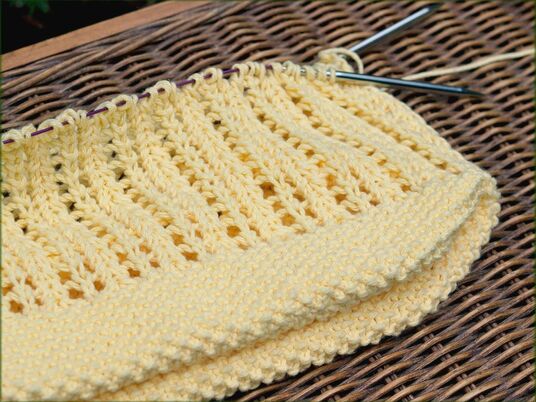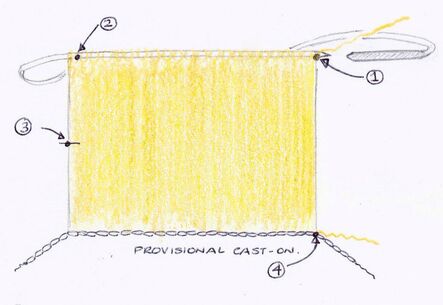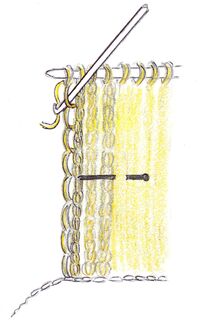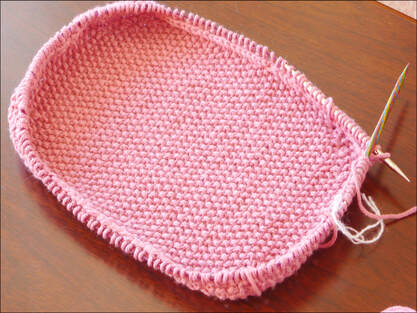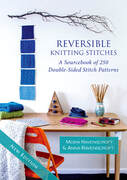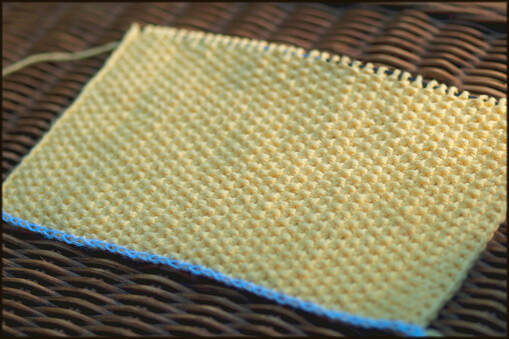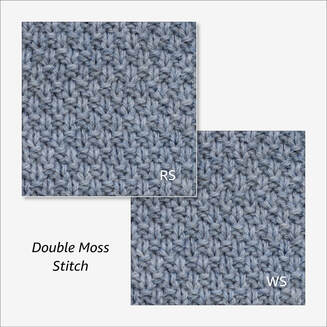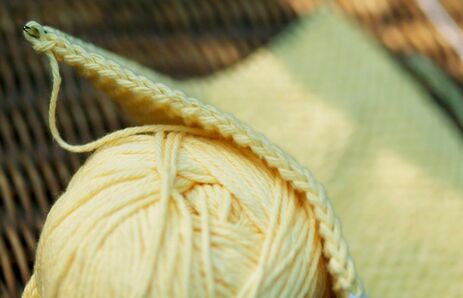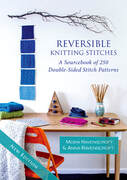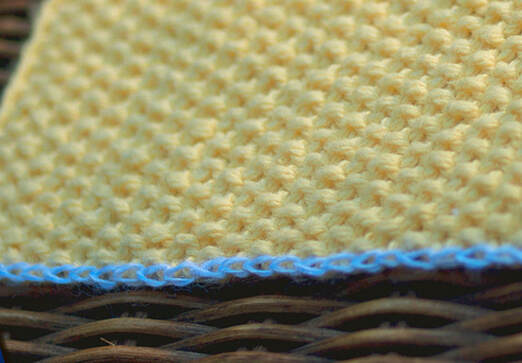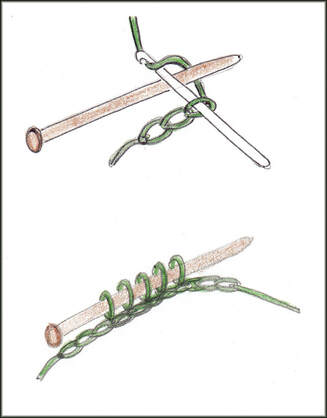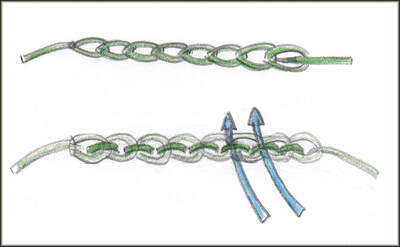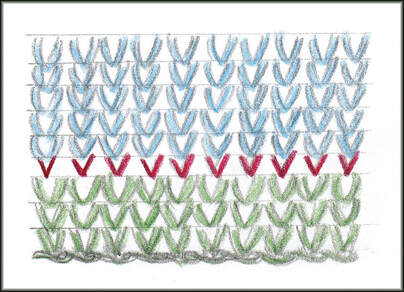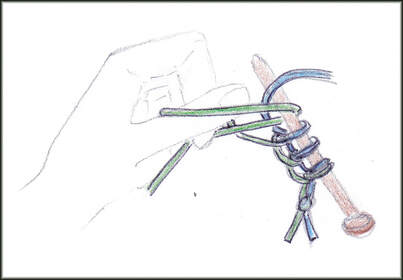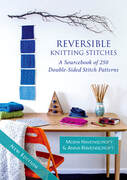So we come to the last of this series of blogposts on working the BYOB Market Bag. If you have just joined me here, then please click here to see the very first post in this series, then follow the links at the bottom of each page until you get back to this point.
In this series, we have been looking at tips and techniques for working a stylish and practical shoulder bag for your next trip to the Farmers’ Market. We started with a discussion about why it is important to pre-wash your yarns, then we looked at gauge swatches, yarn choices and how to work a selvedge. We explored Provisional Cast-Ons and also found a new technique to work an SSK by dividing the working over two rounds. Then we looked at options for adding handles and finishing the bags.
However, one thing remains – and that is whether to line the bags.
Lining Options – a) Lightweight lining
If you do decide you’d like to line your bag then there are three options. The first is to add a very lightweight lining as in the photo above. One of the features of the BYOB Market Bag is that it is light and easy to use, so adding a lightweight liner would seem to be a good choice.
For this bag, I used a very lightweight cotton dress fabric and cut the base to suit the dimensions of the base of the knitted bag. However, for the sides I added a little extra width compared to the unstretched width of the bag and added little pleats at the base when I sewed them in place and then again at the top. This means that I have not lost too much of the flexibility of the bag and it still remains fairly light too.
I added a pocket at the back for my phone and can clip my keys onto a small tab with an attached carabiner hook. This has made a very practical day-bag and I find I am using this one a lot.
In this series, we have been looking at tips and techniques for working a stylish and practical shoulder bag for your next trip to the Farmers’ Market. We started with a discussion about why it is important to pre-wash your yarns, then we looked at gauge swatches, yarn choices and how to work a selvedge. We explored Provisional Cast-Ons and also found a new technique to work an SSK by dividing the working over two rounds. Then we looked at options for adding handles and finishing the bags.
However, one thing remains – and that is whether to line the bags.
- An unlined bag can stretch to accommodate whatever you want to put inside, but won’t take something heavy without sagging.
- A lined bag is stronger but much less flexible.
Lining Options – a) Lightweight lining
If you do decide you’d like to line your bag then there are three options. The first is to add a very lightweight lining as in the photo above. One of the features of the BYOB Market Bag is that it is light and easy to use, so adding a lightweight liner would seem to be a good choice.
For this bag, I used a very lightweight cotton dress fabric and cut the base to suit the dimensions of the base of the knitted bag. However, for the sides I added a little extra width compared to the unstretched width of the bag and added little pleats at the base when I sewed them in place and then again at the top. This means that I have not lost too much of the flexibility of the bag and it still remains fairly light too.
I added a pocket at the back for my phone and can clip my keys onto a small tab with an attached carabiner hook. This has made a very practical day-bag and I find I am using this one a lot.
b) Medium-weight lining
A second option would be to use a slightly thicker cotton fabric as I did with the Weymouth Shoulder Bag which you can see in the photo above. This is a “craft fabric” weight which is often sold for quilting here in the USA. In the Weymouth Shoulder Bag, the fabric fits the bag dimensions more closely and I have also inserted a piece of plastic canvas at the base for extra strength.
This gives a sturdy bag which can easily carry bottles of milk or cartons of orange juice. The plastic canvas base also means that the bag does not sag in the centre when items are added, so is nicely stable.
Something similar to this could be used for your BYOB Market Bag. So if you like this idea, have a look at the Weymouth Shoulder Bag page on my website here for more photos and information.
A second option would be to use a slightly thicker cotton fabric as I did with the Weymouth Shoulder Bag which you can see in the photo above. This is a “craft fabric” weight which is often sold for quilting here in the USA. In the Weymouth Shoulder Bag, the fabric fits the bag dimensions more closely and I have also inserted a piece of plastic canvas at the base for extra strength.
This gives a sturdy bag which can easily carry bottles of milk or cartons of orange juice. The plastic canvas base also means that the bag does not sag in the centre when items are added, so is nicely stable.
Something similar to this could be used for your BYOB Market Bag. So if you like this idea, have a look at the Weymouth Shoulder Bag page on my website here for more photos and information.
c) Purchased bag liner
Then thirdly, it would also be possible to use a purchased bag as a liner for your new BYOB Market Bag. There are many lightweight cotton bags in the shops and you can also find them in supermarkets and on-line sites too, so it should be fairly easy to find just the right-sized liner for your new bag.
Of course, if you haven’t already started your Market Bag then you could design it with the liner in mind. I did that with the Sarasota Shopper in the photo above. This uses a fairly heavy-weight cotton tote from a craft store, which I then dyed. I then designed the outer knitted shell with the same dimensions so that they fit together well.
I have so enjoyed using this bag and it is still in frequent use even after 10 years! After I made this one, I then went on to knit a whole range of bags with this one idea and you can see the full set of five bags in the Southampton Collection here. I especially like the Southampton Book Bag from this collection as I do find shoulder bags so practical. The BYOB Market Bag is also great from this point of view.
The good thing about a purchased liner is that there is minimal sewing involved. All you would need to do is to attach it at the top edge. Or you could leave it unattached and just find a way for it to hang over the handles inside the bag. Then you would have the best of both worlds – a flexible unlined bag when you need one and a stylish alternative to a simple cotton bag when you want to carry a bit more weight.
Then thirdly, it would also be possible to use a purchased bag as a liner for your new BYOB Market Bag. There are many lightweight cotton bags in the shops and you can also find them in supermarkets and on-line sites too, so it should be fairly easy to find just the right-sized liner for your new bag.
Of course, if you haven’t already started your Market Bag then you could design it with the liner in mind. I did that with the Sarasota Shopper in the photo above. This uses a fairly heavy-weight cotton tote from a craft store, which I then dyed. I then designed the outer knitted shell with the same dimensions so that they fit together well.
I have so enjoyed using this bag and it is still in frequent use even after 10 years! After I made this one, I then went on to knit a whole range of bags with this one idea and you can see the full set of five bags in the Southampton Collection here. I especially like the Southampton Book Bag from this collection as I do find shoulder bags so practical. The BYOB Market Bag is also great from this point of view.
The good thing about a purchased liner is that there is minimal sewing involved. All you would need to do is to attach it at the top edge. Or you could leave it unattached and just find a way for it to hang over the handles inside the bag. Then you would have the best of both worlds – a flexible unlined bag when you need one and a stylish alternative to a simple cotton bag when you want to carry a bit more weight.
The BYOB Market Bag
So I hope that has given you lots of ideas for finishing your new BYOB Market Bags. What size to make, whether to use seed stitch or another pattern, length of openwork panel, knitted handles or canvas ones, lined or unlined, inside pockets or not . . .
Certainly there are a lot of options to make just the bag you would like to use for your next trip to the supermarket or to the beach!
Well, I hope you have enjoyed this blogpost series and that it will help you when you are working on your next BYOB Market Bag. For full details of the pattern, please click here. Do make lots for your friends and family too! They would make wonderful gifts for the holiday season.
When I come back next time, I am going to be chatting about some new cushions that I have been making that hope to capture the very essence of summer.
Until then – Happy Knitting!
Moira
So I hope that has given you lots of ideas for finishing your new BYOB Market Bags. What size to make, whether to use seed stitch or another pattern, length of openwork panel, knitted handles or canvas ones, lined or unlined, inside pockets or not . . .
Certainly there are a lot of options to make just the bag you would like to use for your next trip to the supermarket or to the beach!
Well, I hope you have enjoyed this blogpost series and that it will help you when you are working on your next BYOB Market Bag. For full details of the pattern, please click here. Do make lots for your friends and family too! They would make wonderful gifts for the holiday season.
When I come back next time, I am going to be chatting about some new cushions that I have been making that hope to capture the very essence of summer.
Until then – Happy Knitting!
Moira
Last Blogpost: Market Bag Knit-along #7 - Handles and Finishing Next Up: Derwent Cove Cushions Our book: Reversible Knitting Stitches My Website: www.wyndlestrawdesigns.com |
Keywords: Patterns/Bags, Tutorials/BYOB Market Bag Knit-along,
bag, bags, knitted bag, mesh bag, market bag, lined bag, fabric lining, material liner, canvas liner, cotton lining,
bag, bags, knitted bag, mesh bag, market bag, lined bag, fabric lining, material liner, canvas liner, cotton lining,
